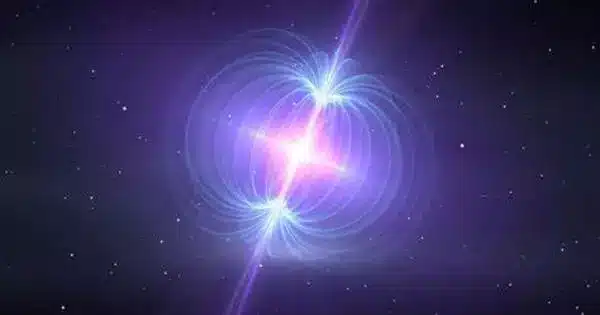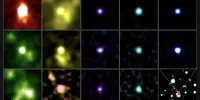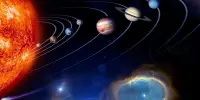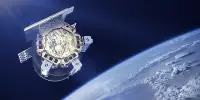An international team has discovered a remote burst of cosmic radio waves lasting less than a millisecond. This ‘rapid radio burst’ (FRB) is the farthest distant ever detected. Its origin was discovered by the European Southern Observatory’s (ESO) Very Large Telescope (VLT) in a galaxy so far away that its light took eight billion years to reach us. The FRB is also one of the most energetic ever witnessed; in a fraction of a second, it produced the equivalent of our Sun’s total emission over 30 years.
The ASKAP radio telescope in Australia [note- 1] discovered the burst, called FRB 20220610A, in June last year, smashing the team’s previous distance record by 50%.
“Using ASKAP’s array of dishes, we were able to determine precisely where the burst came from,” says Stuart Ryder, an astronomer at Australia’s Macquarie University and co-lead author of the study published today in Science. “Then we used [ESO’s VLT] in Chile to search for the source galaxy, [note- 2] finding it to be older and further away than any other FRB source found to date and likely within a small group of merging galaxies.”
Fast radio bursts sense this ionised material. Even in space that is nearly perfectly empty they can ‘see’ all the electrons, and that allows us to measure how much stuff is between the galaxies.
Ryan Shannon
The result demonstrates that FRBs may be used to measure’missing’ stuff between galaxies, allowing for a novel technique to ‘balance’ the Universe.
Current methods of measuring the mass of the Universe produce contradictory results, calling the mainstream model of cosmology into question. “If we count the amount of normal matter in the Universe – the atoms that we are all made of – we find that more than half of what should be there today is missing,” says Ryan Shannon, an Australian academic who co-led the study. “We think that the missing matter is hiding in the space between galaxies, but it may just be so hot and diffuse that it’s impossible to see using normal techniques.”
“Fast radio bursts sense this ionised material. Even in space that is nearly perfectly empty they can ‘see’ all the electrons, and that allows us to measure how much stuff is between the galaxies,” Shannon says.
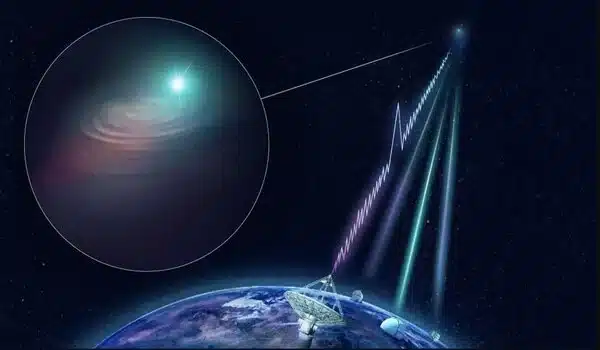
Finding distant FRBs is critical for accurately quantifying the Universe’s missing matter, as demonstrated in 2020 by the late Australian astronomer Jean-Pierre (‘J-P’) Macquart. “J-P demonstrated that the more distant a fast radio-burst is, the more diffuse gas it reveals between galaxies.” This is currently referred to as the Macquart relation. This association looked to be broken by some recent quick radio bursts. “Our measurements show that the Macquart-relation extends beyond half of the known Universe,” Ryder explains.
“While we still don’t know what causes these massive bursts of energy, the paper confirms that fast radio bursts are common events in the cosmos and that we will be able to use them to detect matter between galaxies, and better understand the structure of the Universe,” Shannon said.
The discovery is the limit of what telescopes can achieve today, but scientists will soon have the skills to identify even older and more distant bursts, pinpoint their source galaxies, and calculate the Universe’s missing mass. The international Square Kilometre Array Observatory is currently constructing two radio telescopes in South Africa and Australia that will be capable of detecting thousands of FRBs, even some that are too remote to detect with current technology. The Extremely Large Telescope, a 39-metre telescope under construction in Chile’s Atacama Desert, will be one of the few telescopes capable of studying burst source galaxies even further away than FRB 20220610A.
Notes
[1] The ASKAP telescope is owned and operated by CSIRO, Australia’s national science agency, on Wajarri Yamaji Country in Western Australia.
[2] The team used data obtained with the FOcal Reducer and low dispersion Spectrograph 2 (FORS2), the X-shooter and the High Acuity Wide-field K-band Imager (HAWK-I) instruments on ESO’s VLT. Data from the Keck Observatory in Hawai’i, US, was also used in the study.
